
The Metropolitan Police Department of the District of Columbia (MPDC), more commonly known as the Metropolitan Police Department (MPD), the DC Police, and, colloquially, the DCPD, is the primary law enforcement agency for the District of Columbia, in the United States. With approximately 3,400 officers and 600 civilian staff, it is the sixth-largest municipal police department in the United States. The department serves an area of 68 square miles (180 km2) and a population of over 700,000 people. Established on August 6, 1861, the MPD is one of the oldest police departments in the United States. The MPD headquarters is at the Henry J. Daly Building, located on Indiana Avenue in Judiciary Square across the street from the District of Columbia Court of Appeals and the Superior Court of the District of Columbia. The department's mission is to "safeguard the District of Columbia and protect its residents and visitors with the highest regard for the sanctity of human life". The MPD's regulations are compiled in title 5, chapter 1 of the District of Columbia Code.
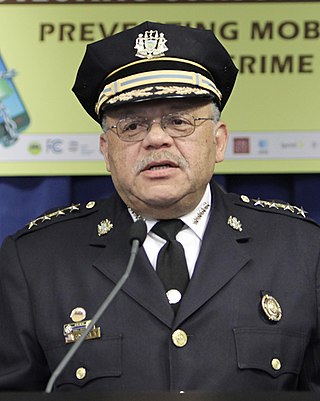
Charles H. Ramsey is the former Commissioner of the Philadelphia Police Department. Prior to assuming that post in January 2008, he had served as Chief of the Metropolitan Police Department of the District of Columbia (MPDC) from 1998 to early 2007. In January 2017, he became a regular CNN contributor.
Crime in Washington, D.C., is directly related to the city's demographics, geography, and unique criminal justice system. The District's population reached a peak of 802,178 in 1950. Shortly after that, the city began losing residents, and by 1980 Washington had lost one-quarter of its population. The population loss to the suburbs also created a new demographic pattern, which divided affluent neighborhoods west of Rock Creek Park from the less well-off neighborhoods to the east.
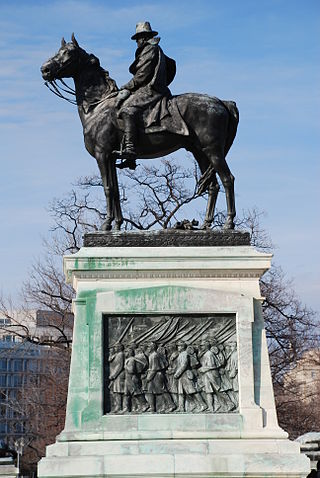
The Ulysses S. Grant Memorial is a presidential memorial in Washington, D.C., honoring American Civil War general and 18th president of the United States, Ulysses S. Grant. It sits at the base of Capitol Hill, below the west front of the United States Capitol. Its central sculpture of Grant on horseback faces west, overlooking the Capitol Reflecting Pool and facing toward the Lincoln Memorial, which honors Grant's wartime president, Abraham Lincoln. Grant's statue is raised on a pedestal decorated with bronze reliefs of the infantry; flanking pedestals hold statues of protective lions and bronze representations of the Union cavalry and artillery. The whole is connected with marble covered platforms, balustrades, and stairs. The Grant and Lincoln memorials define the eastern and western ends, respectively, of the National Mall.

Cathy Lynn Lanier is a former chief of the Metropolitan Police Department of the District of Columbia (MPDC). Lanier was appointed by Washington, D.C. Mayor Adrian Fenty in January 2007, replacing outgoing police chief Charles H. Ramsey. She is the first woman to hold the position. In May 2012, Mayor Vincent C. Gray agreed to retain Lanier as police chief under a new five-year contract. Lanier accepted a third appointment from Mayor Muriel Bowser in 2016, making her the first chief of police in MPD history to serve three mayors. Violent crime dropped 23 percent over the years Lanier was chief, and homicides plunged to a half-century low in 2012. On August 16, 2016, it was announced that Lanier had accepted a position as the senior vice president of security with the National Football League. Her last day as police chief was September 15, 2016, when she was succeeded by her deputy, Peter Newsham. Lanier was the longest serving Chief of Police in the history of the Metropolitan Police Department of the District of Columbia.

The District of Columbia Organic Act of 1871 is an Act of Congress that repealed the individual charters of the cities of Washington and Georgetown and established a new territorial government for the whole District of Columbia. Though Congress repealed the territorial government in 1874, the legislation was the first to create a single municipal government for the federal district.
In United States law, absolute immunity is a type of sovereign immunity for government officials that confers complete immunity from criminal prosecution and suits for damages, so long as officials are acting within the scope of their duties. The Supreme Court of the United States has consistently held that government officials deserve some type of immunity from lawsuits for damages, and that the common law recognized this immunity. The Court reasons that this immunity is necessary to protect public officials from excessive interference with their responsibilities and from "potentially disabling threats of liability."
The Partnership for Civil Justice Fund (PCJF) is a nonprofit progressive legal organization based in Washington, D.C. Founded by Carl Messineo and Mara Verheyden-Hilliard, the organization focuses on cases regarding free speech and dissent, domestic spying and surveillance, police misconduct, and government transparency.

Lafayette Square is a seven-acre public park located within President's Park in Washington, D.C., directly north of the White House on H Street, bounded by Jackson Place on the west, Madison Place on the east and Pennsylvania Avenue on the south. It is named for the general, the Marquis de Lafayette, a French aristocrat, and hero of the American Revolutionary War (1775–1783) and includes several statues of revolutionary heroes from Europe, including Lafayette, while at its center is a famous statue of early 19th century U.S. president and general Andrew Jackson on horseback with both of the horse's front hooves raised.
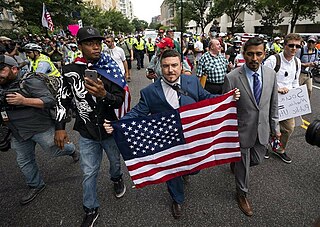
The "Unite the Right 2" rally was a white supremacist rally that occurred on August 12, 2018, at Lafayette Square near the White House in Washington, D.C., United States. It was organized by Jason Kessler to mark the first anniversary of the 2017 Unite the Right rally in Charlottesville, Virginia, which ended in deadly violence and attracted both national and international attention.
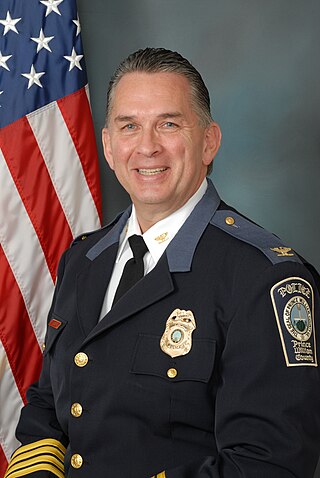
Peter Newsham was the Chief of Police of the Metropolitan Police Department of the District of Columbia (MPD) from January 2017 to January 2021. He is currently Chief of the Prince William County Police Department in Virginia, having been appointed to that post in November, 2020.

The horsemanship of Ulysses S. Grant has been widely acclaimed by his contemporaries and historians as among the most exceptional in American history. Ulysses S. Grant was a commanding general during the Civil War and a two-term U.S. president. Born in Ohio near the Ohio River, Grant grew up around horses, which he came to admire and love, possessing a natural affinity, allowing him to ride, train and manage horses at an early age. His father Jesse placed much confidence in his ability and gave him tasks involving horses that were rarely ever expected of a youth. At age five he was noted for doing difficult stunts bareback and soon after was also performing responsible chores, hauling timber, and driving teams of horses for long distances by himself. From boyhood through his military career, Grant had a well established reputation for training and managing horses. As a youth, neighbors would have him train hard-to-manage horses. As a cadet he set a high-jump record at West Point that stood for a quarter-century.
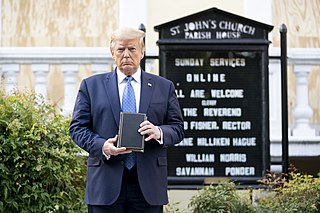
On June 1, 2020, amid the George Floyd protests in Washington, D.C., law enforcement officers used tear gas and other riot control tactics to forcefully clear peaceful protesters from Lafayette Square, creating a path for President Donald Trump and senior administration officials to walk from the White House to St. John's Episcopal Church. Trump held up a Bible and posed for a photo op in front of Ashburton House, which had been damaged by a fire set during protests the night before.

Joseph Randall Biggs is an American veteran, media personality, organizer of the Proud Boys, and convicted felon for his participation in the January 6 United States Capitol attack.

On January 6, 2021, the United States Capitol Building in Washington, D.C., was attacked by a mob of supporters of then-U.S. president Donald Trump, two months after his defeat in the 2020 presidential election. They sought to keep Trump in power by occupying the Capitol and preventing a joint session of Congress counting the Electoral College votes to formalize the victory of President-elect Joe Biden. The attack was ultimately unsuccessful in preventing the certification of the election results. According to the bipartisan House select committee that investigated the incident, the attack was the culmination of a seven-part plan by Trump to overturn the election.

The following article is a broad timeline of the course of events surrounding the attack on the United States Capitol on January 6, 2021, by rioters supporting United States President Donald Trump's attempts to overturn his defeat in the 2020 presidential election. Pro-Trump rioters stormed the United States Capitol after assembling on the Ellipse of the Capitol complex for a rally headlined as the "Save America March".

The January 6 United States Capitol attack was followed by political, legal, and social repercussions. The second impeachment of Donald Trump, who was charged for incitement of insurrection for his conduct, occurred on January 13. At the same time, Cabinet officials were pressured to invoke the 25th Amendment for removing Trump from office. Trump was subsequently acquitted in the Senate trial, which was held in February after Trump had already left office. The result was a 57–43 vote in favor of conviction, with every Democrat and seven Republicans voting to convict, but two-thirds of the Senate are required to convict. Many in the Trump administration resigned. Several large companies announced they were halting all political donations, and others have suspended funding the lawmakers who had objected to certifying Electoral College results. A bill was introduced to form an independent commission, similar to the 9/11 Commission, to investigate the events surrounding the attack; it passed the House but was blocked by Republicans in the Senate. The House then approved a House "select committee" to investigate the attack. In June, the Senate released the results of its own investigation of the attack. The event led to strong criticism of law enforcement agencies. Leading figures within the United States Capitol Police resigned. A large-scale criminal investigation was undertaken, with the Federal Bureau of Investigation (FBI) opening more than 1,200 case files. Federal law enforcement undertook a nationwide manhunt for the perpetrators, with arrests and indictments following within days. Over 890 people had been found guilty of federal crimes.

On January 6, 2021, supporters of then President Donald Trump attacked the U.S. Capitol Building, disrupting the joint session of Congress assembled to count electoral votes to formalize Joe Biden's victory in the 2020 United States Presidential Election. By the end of the month, the Federal Bureau of Investigation (FBI) had opened more than 400 case files and issued more than 500 subpoenas and search warrants related to the riot. The FBI also created a website to solicit tips from the public specifically related to the riot and were especially assisted by the crowdsourced sleuthing group Sedition Hunters. By the end of 2021, 725 people had been charged with federal crimes. That number rose to 1,000 by the second anniversary of the attack, and to 1,200 by the third anniversary, at which point over 890 people had been found guilty of federal crimes. These federal cases are handled by the U.S. Attorney's Office for the District of Columbia (D.C.). State cases, of which there are fewer, are handled in the D.C. Superior Court.

Law enforcement mounted a response to the January 6 United States Capitol attack, initially failing to maintain security perimeters and protect parts of the building from being breached and occupied, but succeeding at protecting members of Congress, and subsequently, as reinforcements arrived, to secure the breached Capitol.
A sitting president of the United States enjoys absolute immunity from many lawsuits while in office; it is under legal dispute whether they also enjoy immunity from criminal liability or prosecution. Neither civil nor criminal immunity is explicitly granted in the Constitution or any federal statute.















